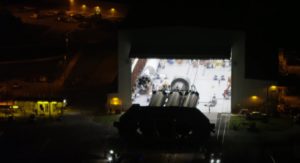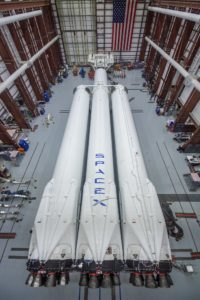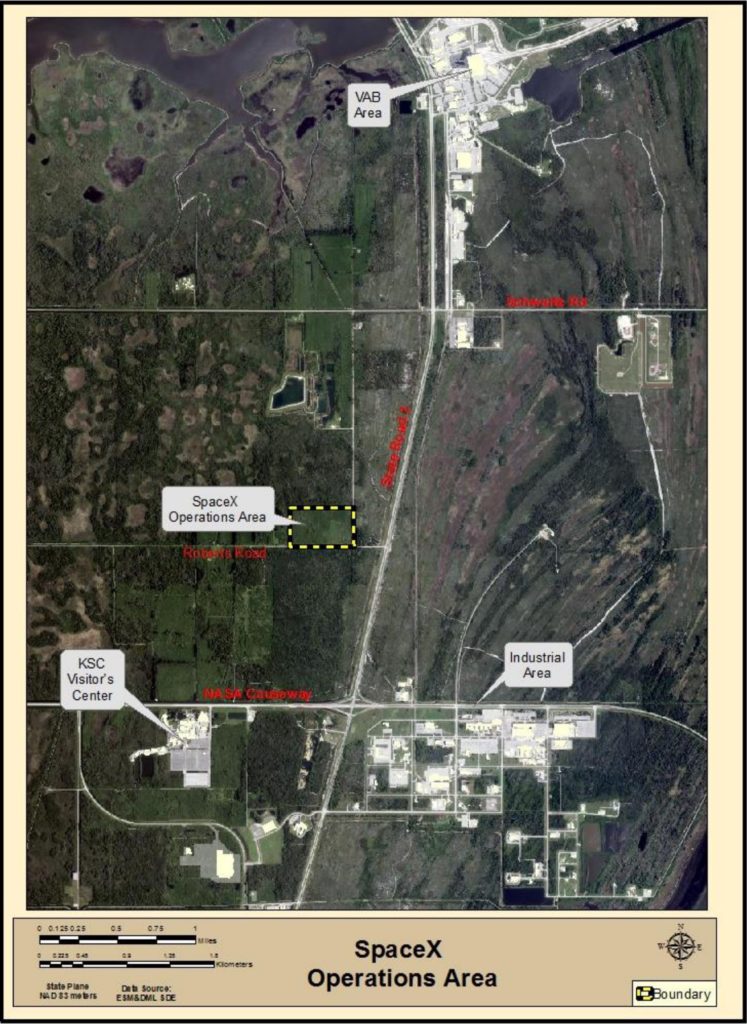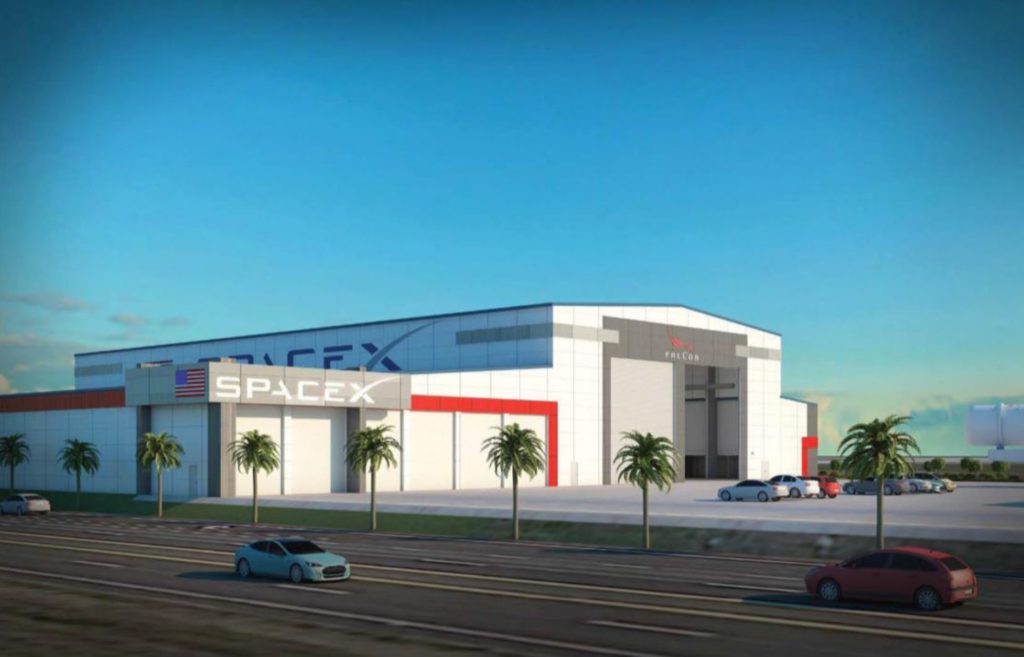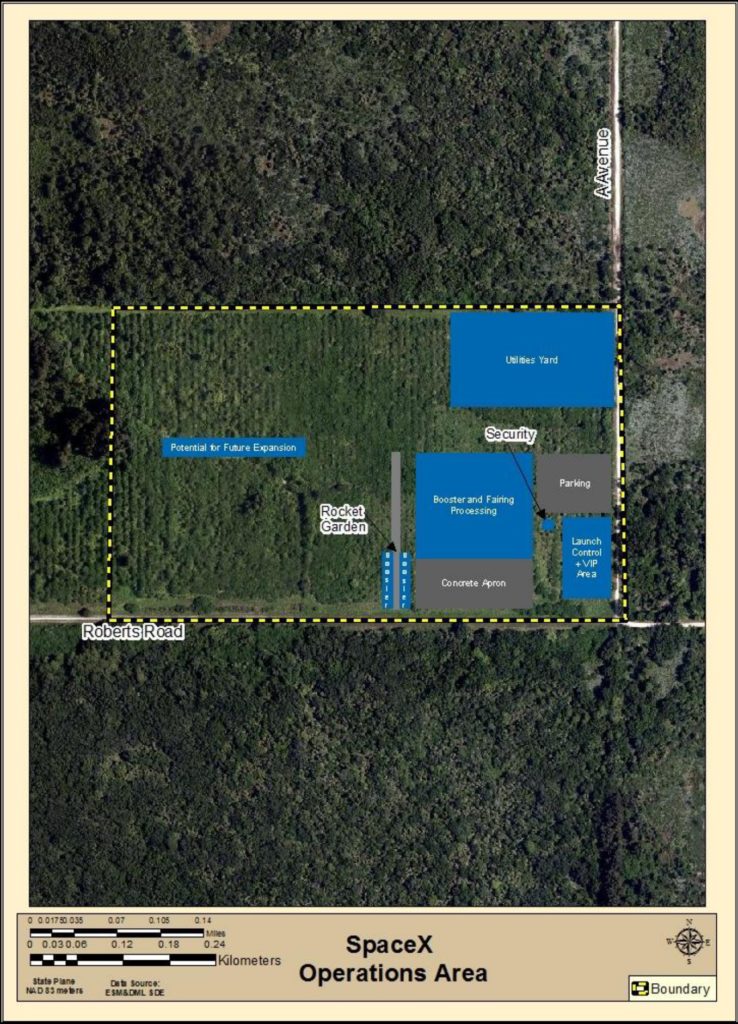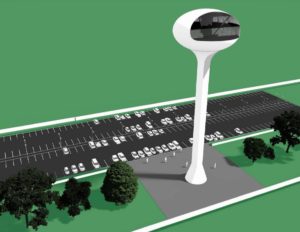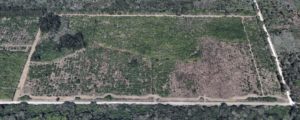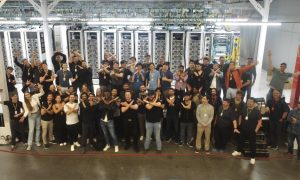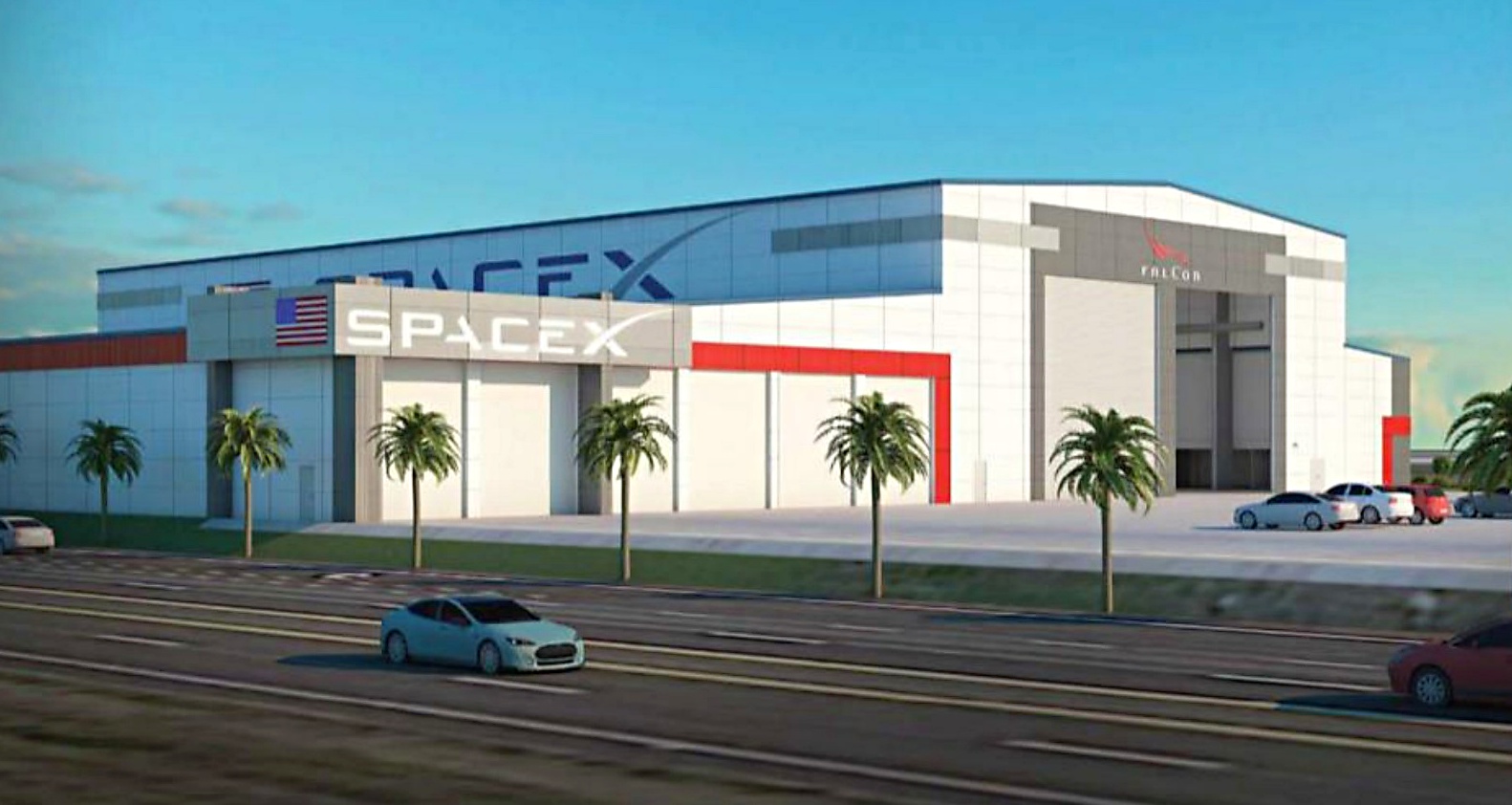

News
SpaceX plans huge expansion for Floridan Falcon refurbishment facilities
According to an environmental assessment published in April 2018, SpaceX aims to build a dedicated facility for storing, refurbishing and decommissioning Falcon 9 and Falcon Heavy boosters and payload fairings “immediately” after construction approvals are granted.
New Falcon 9 and Heavy refurbishment/storage center will be built in Florida
This facility would give SpaceX some 50 acres of land and 130,000 square feet (12,300 m^2) of floor space for the sole purpose of refurbishing and storing flight-proven Falcon 9 and Heavy boosters, as well as the rockets’ payload fairings after successful recoveries begin. If additional storage space proved necessary (and it probably will), another 100,000 ft^2 (9300 m^2) building would be constructed.
- Falcon Heavy rolls out from SpaceX’s largest current booster storage and preparation facility, LC-39A. (SpaceX)
- The first-ever Falcon Heavy (sans payload and fairing) shown inside Pad 39A’s horizontal integration facility (HIF). (SpaceX)
As of today, SpaceX likely has room to store 6-8 Falcon boosters at or near their Florida launch pads, with the bulk of that storage coming from the company’s 50,000 ft^2 (4500 m^2) LC-39A horizontal integration facility (HIF), capable of housing four rocket boosters. As such, an additional 150,000+ ft^2 could nearly quadruple SpaceX’s booster storage and refurbishment capabilities, all while locating that expansion on a single, easily-accessible lot within close reach of both LC-40 and LC-39A launch pads.
Put more simply, the addition of this new Kennedy Space Center facility would hugely benefit SpaceX’s ability to launch, land, and re-launch its reusable rockets as rapidly as possible, and would enable the simultaneous storage and refurbishment of as many as 16-20 Falcon 9/Heavy boosters and at least a dozen payload fairing halves. If even more capacity is required, nearly half of lot SpaceX wants to lease would be untouched and give the company another 30 acres of land to expand into as launch cadence ramps or BFR prepares for its first launches from Florida.
- An overview of SpaceX’s prospective KSC facility and nearby landmarks. (SpaceX)
- A SpaceX render of what the complex might look like once completed. (SpaceX)
- As described in the environmental assessment, more than half of the lot would be free for future expansion. (SpaceX)
60+ annual launches, rocket ‘gardens’, and a wacky control tower
According to comments in the April 2018 assessment, the readiness of these new storage and refurbishment facilities could potentially pave the way for – as early as 2020 – more than 60 annual Falcon 9 and Heavy launches from the company’s two Florida launch pads a number which doesn’t even include SpaceX’s California launch site, nor its prospective Texas launch facilities. In order to support ambitious Florida-specific launch rates, SpaceX also intends to construct a 300-foot tall Launch and Landing Control Center (LLCC) pulled straight from a Bond villain’s lair on the new property.
The [LLCC] is envisioned to be world-class, architecturally distinctive, and equipped for satellite, cargo, and crew missions.
- SpaceX’s proposed Launch and Landing Control Center (LLCC). The Bond villain is strong with this one… (SpaceX)
- Satellite imagery from Google Maps shows the currently-abandoned site of SpaceX’s prospective Florida expansion. (Google Maps)
Distinctive is certainly a good way to describe the proposed control center. Not to be outdone, SpaceX also included plans for its own private rocket garden, essentially an elegant graveyard for decommissioned or uniquely historic Falcon 9 and Heavy rocket boosters and fairings, as well as Dragon spacecraft. Perhaps there will be room for pathfinder Mars rockets and spaceships in the future… With any luck, both the control center and proposed rocket garden are intended to be at least partially open to the public, something that would undoubtedly be a huge hit while also awkwardly competing with Kennedy Space Center’s Visitor Center, which features its own rocket garden less than a mile away.
Although BFR and Mars were never mentioned specifically, something SpaceX appears to have been quite stringent about over the last several months, the environmental assessment also briefly mentioned future uses for the same facility that might include “new launch vehicle” developments, perhaps requiring a four-lane expansion of the adjacent Robert’s Road somewhere down the line.
Follow us for live updates, peeks behind the scenes, and photos from Teslarati’s East and West Coast photographers.
Teslarati – Instagram – Twitter
Tom Cross – Twitter
Pauline Acalin – Twitter
Eric Ralph – Twitter
News
Tesla launches in India with Model Y, showing pricing will be biggest challenge
Tesla finally got its Model Y launched in India, but it will surely come at a price for consumers.

Tesla has officially launched in India following years of delays, as it brought its Model Y to the market for the first time on Tuesday.
However, the launch showed that pricing is going to be its biggest challenge. The all-electric Model Y is priced significantly higher than in other major markets in which Tesla operates.
On Tuesday, Tesla’s Model Y went up for sale for 59,89,000 rupees for the Rear-Wheel Drive configuration, while the Long Range Rear-Wheel Drive was priced at 67,89,000.
This equates to $69,686 for the RWD and $78,994 for the Long Range RWD, a substantial markup compared to what these cars sell for in the United States.
🚨 Here’s the difference in price for the Tesla Model Y in the U.S. compared to India.
🚨 59,89,000 is $69,686
🚨 67,89,000 is $78,994 pic.twitter.com/7EUzyWLcED— TESLARATI (@Teslarati) July 15, 2025
Deliveries are currently scheduled for the third quarter, and it will be interesting to see how many units they can sell in the market at this price point.
The price includes tariffs and additional fees that are applied by the Indian government, which has aimed to work with foreign automakers to come to terms on lower duties that increase vehicle cost.
Tesla Model Y seen testing under wraps in India ahead of launch
There is a chance that these duties will be removed, which would create a more stable and affordable pricing model for Tesla in the future. President Trump and Indian Prime Minister Narendra Modi continue to iron out those details.
Maharashtra Chief Minister Devendra Fadnavis said to reporters outside the company’s new outlet in the region (via Reuters):
“In the future, we wish to see R&D and manufacturing done in India, and I am sure at an appropriate stage, Tesla will think about it.”
It appears to be eerily similar to the same “game of chicken” Tesla played with Indian government officials for the past few years. Tesla has always wanted to enter India, but was unable to do so due to these import duties.
India wanted Tesla to commit to building a Gigafactory in the country, but Tesla wanted to test demand first.
It seems this could be that demand test, and the duties are going to have a significant impact on what demand will actually be.
Elon Musk
Tesla ups Robotaxi fare price to another comical figure with service area expansion
Tesla upped its fare price for a Robotaxi ride from $4.20 to, you guessed it, $6.90.

Tesla has upped its fare price for the Robotaxi platform in Austin for the first time since its launch on June 22. The increase came on the same day that Tesla expanded its Service Area for the Robotaxi ride-hailing service, offering rides to a broader portion of the city.
The price is up from $4.20, a figure that many Tesla fans will find amusing, considering CEO Elon Musk has used that number, as well as ’69,’ as a light-hearted attempt at comedy over the past several years.
Musk confirmed yesterday that Tesla would up the price per ride from that $4.20 point to $6.90. Are we really surprised that is what the company decided on, as the expansion of the Service Area also took effect on Monday?
But the price is now a princely $6.90, as foretold in the prophecy 😂
— Elon Musk (@elonmusk) July 14, 2025
The Service Area expansion was also somewhat of a joke too, especially considering the shape of the new region where the driverless service can travel.
I wrote yesterday about how it might be funny, but in reality, it is more of a message to competitors that Tesla can expand in Austin wherever it wants at any time.
Tesla’s Robotaxi expansion wasn’t a joke, it was a warning to competitors
It was only a matter of time before the Robotaxi platform would subject riders to a higher, flat fee for a ride. This is primarily due to two reasons: the size of the access program is increasing, and, more importantly, the service area is expanding in size.
Tesla has already surpassed Waymo in Austin in terms of its service area, which is roughly five square miles larger. Waymo launched driverless rides to the public back in March, while Tesla’s just became available to a small group in June. Tesla has already expanded it, allowing new members to hail a ride from a driverless Model Y nearly every day.
The Robotaxi app is also becoming more robust as Tesla is adding new features with updates. It has already been updated on two occasions, with the most recent improvements being rolled out yesterday.
Tesla updates Robotaxi app with several big changes, including wider service area
News
Tesla Model Y and Model 3 dominate U.S. EV sales despite headwinds
Tesla’s two mainstream vehicles accounted for more than 40% of all EVs sold in the United States in Q2 2025.

Tesla’s Model Y and Model 3 remained the top-selling electric vehicles in the U.S. during Q2 2025, even as the broader EV market dipped 6.3% year-over-year.
The Model Y logged 86,120 units sold, followed by the Model 3 at 48,803. This means that Tesla’s two mainstream vehicles accounted for 43% of all EVs sold in the United States during the second quarter, as per data from Cox Automotive.
Tesla leads amid tax credit uncertainty and a tough first half
Tesla’s performance in Q2 is notable given a series of hurdles earlier in the year. The company temporarily paused Model Y deliveries in Q1 as it transitioned to the production of the new Model Y, and its retail presence was hit by protests and vandalism tied to political backlash against CEO Elon Musk. The fallout carried into Q2, yet Tesla’s two mass-market vehicles still outsold the next eight EVs combined.
Q2 marked just the third-ever YoY decline in quarterly EV sales, totaling 310,839 units. Electric vehicle sales, however, were still up 4.9% from Q1 and reached a record 607,089 units in the first half of 2025. Analysts also expect a surge in Q3 as buyers rush to qualify for federal EV tax credits before they expire on October 1, Cox Automotive noted in a post.
Legacy rivals gain ground, but Tesla holds its commanding lead
General Motors more than doubled its EV volume in the first half of 2025, selling over 78,000 units and boosting its EV market share to 12.9%. Chevrolet became the second-best-selling EV brand, pushing GM past Ford and Hyundai. Tesla, however, still retained a commanding 44.7% electric vehicle market share despite a 12% drop in in Q2 revenue, following a decline of almost 9% in Q1.
Incentives reached record highs in Q2, averaging 14.8% of transaction prices, roughly $8,500 per vehicle. As government support winds down, the used EV market is also gaining momentum, with over 100,000 used EVs sold in Q2.
Q2 2025 Kelley Blue Book EV Sales Report by Simon Alvarez on Scribd
-

 News3 days ago
News3 days agoTesla debuts hands-free Grok AI with update 2025.26: What you need to know
-

 Elon Musk6 days ago
Elon Musk6 days agoxAI launches Grok 4 with new $300/month SuperGrok Heavy subscription
-

 Elon Musk1 week ago
Elon Musk1 week agoElon Musk confirms Grok 4 launch on July 9 with livestream event
-

 News2 weeks ago
News2 weeks agoTesla Model 3 ranks as the safest new car in Europe for 2025, per Euro NCAP tests
-

 Elon Musk2 weeks ago
Elon Musk2 weeks agoxAI’s Memphis data center receives air permit despite community criticism
-

 News5 days ago
News5 days agoTesla begins Robotaxi certification push in Arizona: report
-

 Elon Musk2 weeks ago
Elon Musk2 weeks agoTesla reveals it is using AI to make factories more sustainable: here’s how
-

 Elon Musk2 weeks ago
Elon Musk2 weeks agoTesla scrambles after Musk sidekick exit, CEO takes over sales

